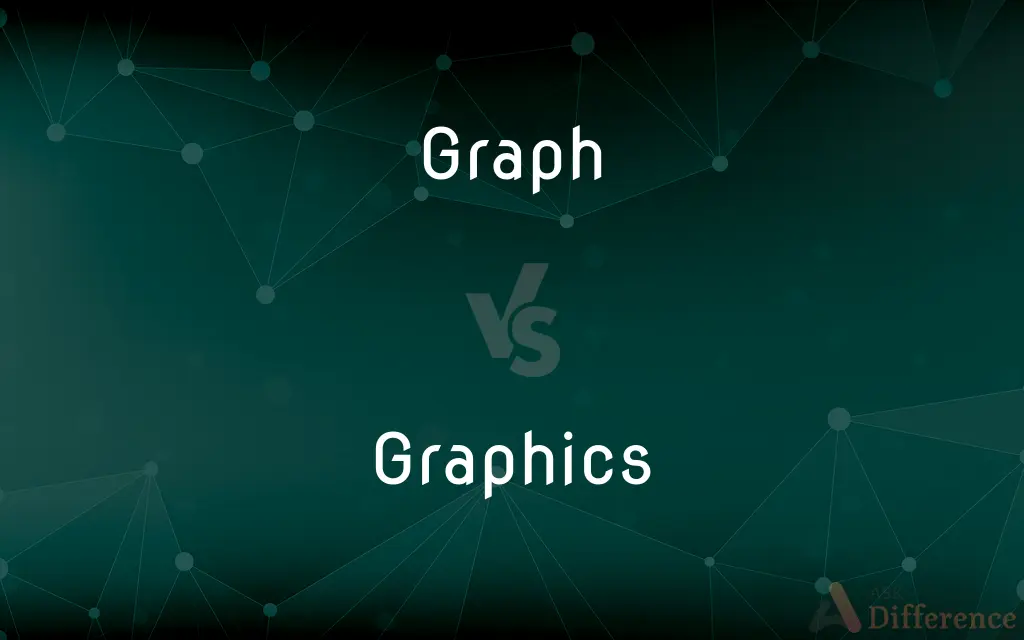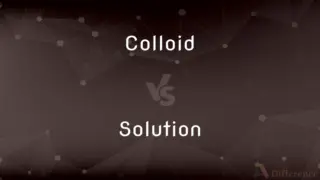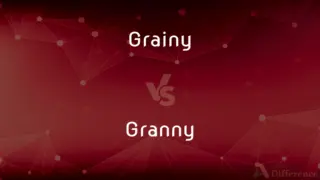Graph vs. Graphics — What's the Difference?
By Tayyaba Rehman — Updated on October 26, 2023
"Graph" is a diagram that displays the relationship between variables, while "graphics" are visual representations like images and designs.

Difference Between Graph and Graphics
Table of Contents
ADVERTISEMENT
Key Differences
A graph is a type of diagram that represents data or values, typically showing the relationship between two or more variables. It’s often used in mathematics, science, and statistics. Graphics, on the other hand, encompass a wider range of visual representations including drawings, designs, and images used in various fields such as art, design, and digital media.
Graphs are tools for visualizing data to simplify the understanding of quantitative relationships. They come in various forms like bar graphs, line graphs, or pie charts, each serving a specific purpose in data representation. Graphics are not restricted to data representation; they include any form of visual artwork, digital designs, and even animations.
The creation of a graph is usually based on numerical data and involves plotting points or drawing lines or bars to represent values. Its primary goal is to convey information in a clear and concise manner. Graphics creation, however, can be based on artistic vision or design principles and can be used for a variety of purposes, from advertising to entertainment.
Graphs are commonly used in academic and professional settings for research, analysis, and presenting factual information. Graphics find broader application in areas like website design, video games, marketing materials, and more, where aesthetic and creative aspects are paramount.
While graphs are generally more structured and standardized in their appearance, adhering to specific rules and formats, graphics have a wide range of styles, techniques, and presentations, allowing for more creativity and personal expression.
ADVERTISEMENT
Comparison Chart
Definition
Diagram showing data relationships
Visual representations, including images and designs
Purpose
Visualize and simplify data understanding
Artistic, design, and visual communication
Basis
Often based on numerical data
Can be based on artistic or design concepts
Usage
Common in academic, scientific, and professional contexts
Used in art, design, digital media, marketing, etc.
Structure
Structured and standardized
Diverse styles and creative flexibility
Compare with Definitions
Graph
A chart used to convey information visually.
The teacher used a bar graph to explain the survey data.
Graphics
The art of creating visual content.
She excels in creating innovative graphics for websites.
Graph
A visual representation of statistical data.
The graph clearly showed the rise in temperature.
Graphics
Visual artwork, designs, or illustrations.
The book cover had stunning graphics.
Graph
A diagram that exhibits a relationship, often functional, between two sets of numbers as a set of points having coordinates determined by the relationship. Also called plot.
Graphics
Computer-generated imagery or digital designs.
The video game featured high-quality graphics.
Graph
A pictorial device, such as a pie chart or bar graph, used to illustrate quantitative relationships. Also called chart.
Graphics
Images or designs used in visual communication.
The advertisement used bold graphics to attract attention.
Graph
The spelling of a word.
Graphics
Graphics (from Greek γραφικός graphikos, "belonging to drawing") are visual images or designs on some surface, such as a wall, canvas, screen, paper, or stone to inform, illustrate, or entertain. In contemporary usage, it includes a pictorial representation of data, as in c manufacture, in typesetting and the graphic arts, and in educational and recreational software.
Graph
Any of the possible forms of a grapheme.
Graphics
(used with a sing. verb) The making of drawings in accordance with the rules of mathematics, as in engineering or architecture.
Graph
A written character that represents a vowel, consonant, syllable, word, or other expression and that cannot be further analyzed.
Graphics
(used with a pl. verb) Calculations, as of structural stress, from such drawings.
Graph
To represent by a graph.
Graphics
(used with a sing. or pl. verb) See graphic arts.
Graph
To plot (a function) on a graph.
Graphics
(used with a sing. or pl. verb) The pictorial representation and manipulation of data, as used in computer-aided design and manufacture, in typesetting and the graphic arts, and in educational and recreational programs.
Graph
A data chart (graphical representation of data) intended to illustrate the relationship between a set (or sets) of numbers (quantities, measurements or indicative numbers) and a reference set, whose elements are indexed to those of the former set(s) and may or may not be numbers.
Graphics
(used with a sing. verb) The process by which a computer displays data pictorially.
Graph
(mathematics) A set of points constituting a graphical representation of a real function; (formally) a set of tuples , where for a given function . See also Graph of a function Category:en:Curves Category:en:Functions
Graphics
The making of architectural or design drawings.
Graph
(graph theory) A set of vertices (or nodes) connected together by edges; (formally) an ordered pair of sets , where the elements of are called vertices or nodes and is a set of pairs (called edges) of elements of . See also Graph (discrete mathematics)
Graphics
The graphic arts.
Graph
(topology) A topological space which represents some graph (ordered pair of sets) and which is constructed by representing the vertices as points and the edges as copies of the real interval [0,1] (where, for any given edge, 0 and 1 are identified with the points representing the two vertices) and equipping the result with a particular topology called the graph topology.
Graphics
(computing) The pictorial representation and manipulation of data; the process by which a computer displays data.
Graph
A morphism from the domain of to the product of the domain and codomain of , such that the first projection applied to equals the identity of the domain, and the second projection applied to is equal to .
Graphics
(computing) The art or visual representations displayed by a computer.
This game is really fun, but the graphics aren't very good.
Graph
A graphical unit on the token-level, the abstracted fundamental shape of a character or letter as distinct from its ductus (realization in a particular typeface or handwriting on the instance-level) and as distinct by a grapheme on the type-level by not fundamentally distinguishing meaning.
Graphics
The art or the science of drawing; esp. of drawing according to mathematical rules, as in perspective, projection, and the like.
Graph
(transitive) To draw a graph.
Graphics
Photographs or other visual representations in a printed publication;
The publisher was responsible for all the artwork in the book
Graph
To draw a graph of a function.
Graphics
The drawings and photographs in the layout of a book
Graph
A curve or surface, the locus of a point whose coördinates are the variables in the equation of the locus; as, a graph of the exponential function.
Graphics
Visual elements in printed material or digital media.
The brochure's graphics made it visually appealing.
Graph
A diagram symbolizing a system of interrelations of variable quantities using points represented by spots, or by lines to represent the relations of continuous variables. More than one set of interrelations may be presented on one graph, in which case the spots or lines are typically distinguishable from each other, as by color, shape, thickness, continuity, etc. A diagram in which relationships between variables are represented by other visual means is sometimes called a graph, as in a bar graph, but may also be called a chart.
Graph
A drawing illustrating the relations between certain quantities plotted with reference to a set of axes
Graph
Represent by means of a graph;
Chart the data
Graph
Plot upon a graph
Graph
A diagram showing the relationship between sets of numbers.
The line graph displayed the company's sales over the years.
Graph
A mathematical representation of data.
He plotted a graph to analyze the experiment's results.
Graph
A plot of values, often on x and y axes.
The scatter graph depicted the correlation between age and spending.
Common Curiosities
What is a graph?
A graph is a visual representation of data, often showing relationships between variables.
Can a graph be artistic?
While graphs are typically structured, creative design can be applied for visual appeal.
Are all graphics computer-generated?
Graphics can be both computer-generated and hand-drawn.
What are graphics?
Graphics are visual representations including artwork, designs, and digital images.
Is photography considered graphics?
Yes, photographs can be considered a form of graphics, especially in design contexts.
Can graphs be 3D?
Yes, there are 3D graphs that represent more complex data sets.
Are graphs only used in science?
No, graphs are used in various fields including business, economics, and more.
Do graphs always use numbers?
Most graphs are based on numerical data but can also include textual information.
Can a single graph represent multiple data sets?
Yes, graphs like line graphs can represent multiple data sets for comparison.
Do graphics include animations?
Yes, animations are a form of graphics, particularly in digital media.
Do graphics always convey information?
Graphics can be informational or purely aesthetic, depending on their purpose.
Are logos considered graphics?
Yes, logos are a type of graphic design.
Is it necessary for graphs to have labels?
Labels are important for clarity but some simple graphs might not have them.
Can a graph be without axes?
Certain types of graphs, like pie charts, don't require axes.
Is web design part of graphics?
Yes, web design involves graphics for visual communication and user interface.
Share Your Discovery

Previous Comparison
Colloid vs. Solution
Next Comparison
Grainy vs. GrannyAuthor Spotlight
Written by
Tayyaba RehmanTayyaba Rehman is a distinguished writer, currently serving as a primary contributor to askdifference.com. As a researcher in semantics and etymology, Tayyaba's passion for the complexity of languages and their distinctions has found a perfect home on the platform. Tayyaba delves into the intricacies of language, distinguishing between commonly confused words and phrases, thereby providing clarity for readers worldwide.















































